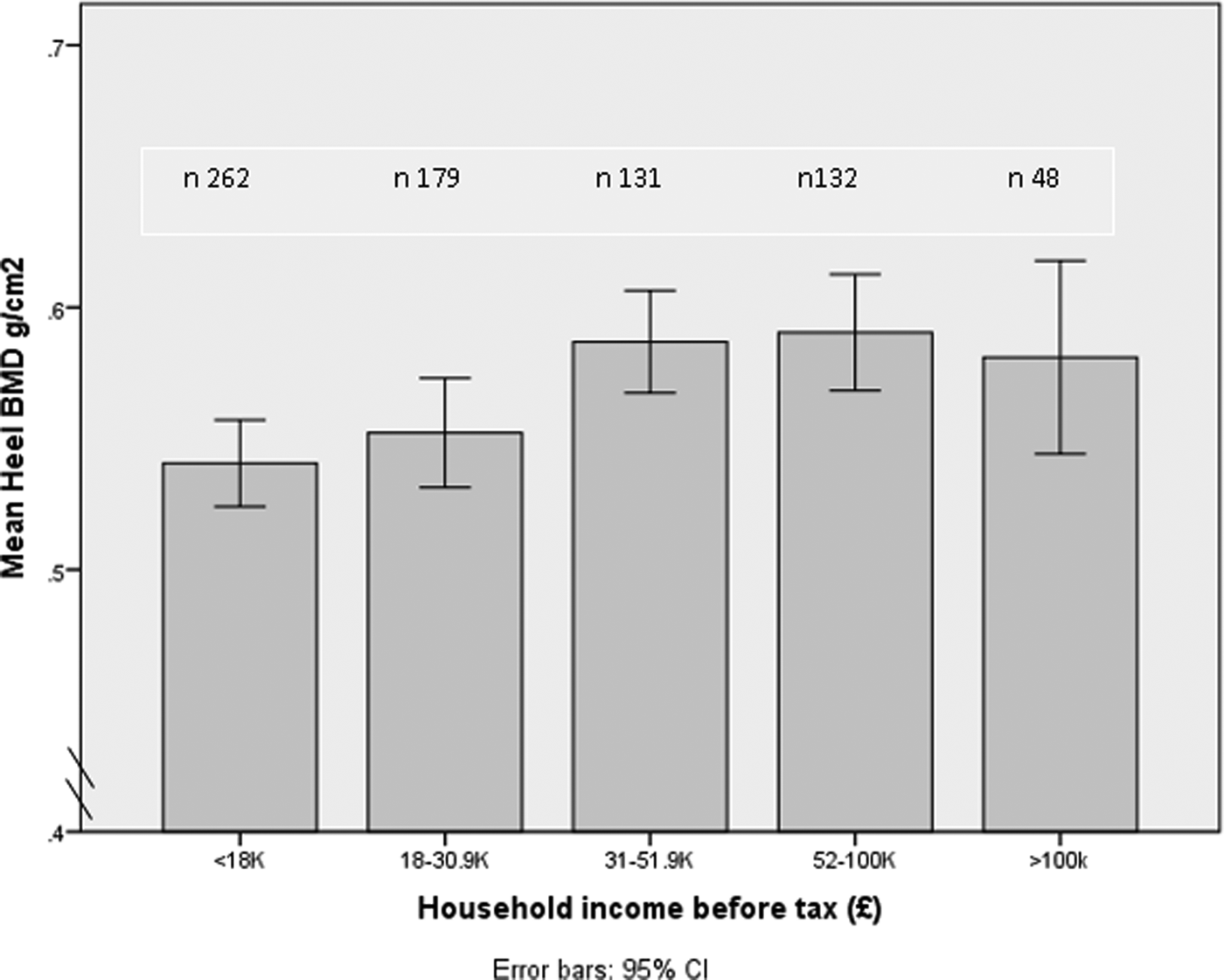Osteoporosis is a skeletal disease associated with ageing, characterised by low bone mineral density (BMD) and associated with very large health and social care costs. There is an urgent need for large scale research to identify putative modifiable risk factors associated with low BMD in ethnic minority groups, whereby research to date has been piecemeal. In this study we investigate the association between heel (calcaneal) bone ultrasound attenuation (BUA) (a measure of BMD) and dietary, lifestyle and anthropometric factors in South Asians from the UK Biobank. The UK Biobank (http://www.ukbiobank.ac.uk/) is a large ongoing UK-wide cohort( Reference Sudlow, Gallacher and Allen 1 ) with data on > 500,000 individuals, aged 40–69 years, recruited from 2006–2010. The current analysis uses data from n 2438 South Asians (n 1079 females, n 1359 males; n 114 Bangladeshi, n 1625 Indian and n 699 Pakistani) who had a heel BUA measurement conducted at baseline. Mean (+/− SD) for age was 53+/−8 years and for Body Mass Index (BMI) was 27(5) kg/m2.
Spearman's or Pearson's partial correlations (as appropriate) were undertaken to assess the association between heel BMD and the following variables, controlling for subject age: gross household income, waist:hip ratio, BMI, median calcium and vitamin D intakes, days per week walked 10 minutes or more, Townsend Deprivation Index (TDI), number of hours outdoors in summer, and oily fish consumption. Chi square analyses were used to assess the association between heel BMD (categorised as above or below the group median, within sex) and ethnic subgroup, self-related health, smoking status (males only as few females smoked), occupation, vegetarianism (Indians only assessed as other groups had few vegetarians), alcohol intake, vitamin D containing supplement use and education. P values presented are unadjusted, but a Bonferroni adjusted P value cut-off for statistical significance of P < 0·0015 was used, rather than P < 0·05, to adjust for multiple testing (n = 33 tests).
In females, there was a positive partial correlation between gross household income and heel BMD (r = 0·17 P < 0·001 n 752). In males, there was a positive partial correlation between BMI and heel BMD (r = 0·07 P < 0·001 n 1349). See Figures 1–2 for an illustration of these associations (female data presented as a bar chart as income data were ordinal).

Fig. 1. Income and BMD (females) (P < 0·001)

Fig. 2. BMI and BMD (males) (r = 0·07, P < 0·001)
However, there were no statistically significant associations (P > 0·05) between heel BMD and all other outcomes assessed. Our results suggest that when controlling for age, having a lower income (females) or a lower BMI (males), are associated with lower heel BMD. Western dwelling South Asians with these particular characteristics may benefit from public health interventions to improve bone health.
This is the first analysis to date assessing the association between heel BUA, dietary, lifestyle and anthropometric factors in a large UK South Asian cohort. However, one limitation of this study is the use of BUA estimated BMD as a method for assessing bone health. We are now conducting further work using the UK Biobank South Asian data to assess whether dietary, lifestyle and anthropometric factors are associated with more clinically relevant measures of bone health (e.g. hip, wrist and spine BMD).
This research has been conducted using the UK Biobank Resource under application number 15168.




